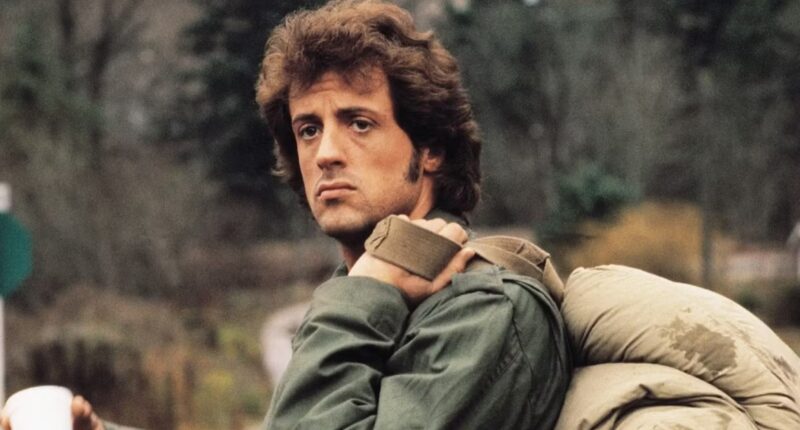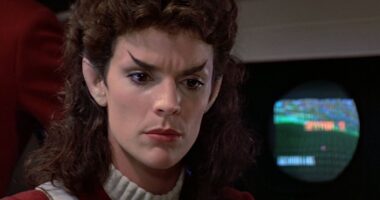Share this @internewscast.com
Sylvester Stallone, having firmly established himself with the “Rocky” series, made a significant leap into action thrillers by portraying John Rambo in “First Blood.” This film, adapted from David Morrell’s renowned novel—which concludes quite differently than the movie—allowed Stallone to craft a distinctive portrayal of a haunted Vietnam veteran. His influence on action cinema was profound, transforming the genre and cementing Rambo’s status as a legendary character, even for those unfamiliar with every movie. Curious about the number of “Rambo” films and the best viewing order?
Following the 1982 release of “First Blood,” a sequel quickly emerged in 1985, with a third installment arriving a few years later. After a lengthy hiatus, Rambo returned to theaters with a fourth installment in 2008, and a concluding chapter was released 11 years after that. With five official films in the series—and whispers of a prequel in the works—fans might wonder about the optimal viewing order. The answer is simple: follow the release sequence.
The “Rambo” series benefits from a straightforward progression, unburdened by extraneous sequels or spin-offs, allowing viewers to enjoy a coherent narrative arc. The chronological and release orders are identical, providing a seamless viewing experience. “First Blood” introduces Stallone’s Rambo with gripping storytelling, adapted from the thriller novel. “Rambo: First Blood Part II” follows, delving deeper into Rambo’s experiences in Vietnam. The third film shifts focus to Cold War tensions while maintaining continuity. The saga paused for two decades until Stallone resurrected his iconic character, seeing untapped potential in Rambo’s story.
- “First Blood” (1982)
- “Rambo: First Blood Part II” (1985)
- “Rambo III” (1988)
- “Rambo” (2008)
- “Rambo: Last Blood” (2019)
Stallone’s work on “Rocky” and “Rambo” films throughout the 1980s mirrored each other, and this pattern repeated years later. After the 2006 release of “Rocky Balboa,” Stallone revived Rambo in the 2008 film “Rambo,” which he directed himself. Although many sequels were proposed, each film built upon the previous one, shaping John Rambo into a character deeply marked by warfare’s brutality. The final installment, “Rambo: Last Blood,” released in 2019, finds Rambo confronting his past and making sacrifices for loved ones, ending his journey with a fitting sunset ride reminiscent of classic heroes.
Chronological and release order are the same for Rambo
“First Blood” stands out as the quintessential Rambo film, capturing the essence of the character’s narrative. Both the film and Morrell’s novel present a standalone action thriller. Stallone’s portrayal of Rambo offers an intensity distinct from his Rocky Balboa role, drawing audiences into the protagonist’s struggle as he grapples with his traumatic past in a hostile Washington town. After a violent clash with local law enforcement, Rambo retreats to the mountains, preparing for a new battle, claiming, “They drew first blood, not me,” evoking deep empathy from viewers.
For “First Blood,” Stallone conducted interviews with 20 veterans to ensure authenticity in each scene. Given the film’s politically charged atmosphere during its time, Stallone aimed for accuracy. The film remains unmatched in its portrayal of post-Vietnam War American paranoia, as Rambo battles his demons while facing a society eager to judge him harshly. The film also features Brian Dennehy as the memorable Sheriff Will Teasle and Richard Crenna as Colonel Samuel Trautman, Rambo’s mentor and former commanding officer, in his first of three franchise appearances.
First Blood (1982)
Kickstarting the franchise, “First Blood” is easily the best part of the overall John Rambo story. Not only is it an entirely self-contained film, but that’s how David Morrell wrote the novel as well: A one-and-done action thriller. Sylvester Stallone shines here in a way he never could as Rocky Balboa, pulling the audience down with him as Rambo struggles with his time overseas upon wandering through a small Washington town that wants nothing to do with him. After a physical altercation and abuse at the hands of local law enforcement turns ugly, Rambo takes matters into his own hands, secluding himself in the mountains while preparing for a new war. “They drew first blood, not me,” he cries, and we can’t help but feel for him.
In preparation for “First Blood,” Stallone interviewed 20 different veterans to nail each scene. With how politically charged this action thriller was back in its still-fresh era, he wanted to make sure he got everything right. To this day, there isn’t another action flick quite like it. The paranoia of post-Vietnam War America is on full display here as Rambo struggles with his own sanity while trying to defend himself from others who see him as a threat, happy to mark him with their merciless, uncaring judgment. Alongside Stallone, Brian Dennehy plays the memorable Sheriff Will Teasle, and Richard Crenna makes his first of three appearances in the franchise as Rambo’s mentor and former commanding officer, Colonel Samuel Trautman.
With “First Blood,” the “Rambo” franchise kicks off with one of the biggest bangs an action series could begin with. It’s unsettling, entertaining, and thought-provoking all at the same time, reminding us why Rambo so quickly became known not just nationwide but around the world as well. Long before there was Keanu Reeves as John Wick, there was Stallone as John Rambo.
Rambo: First Blood Part II (1985)
Set three years after the events of the first film, “Rambo: First Blood Part II” continues the saga as Rambo is sent back to Vietnam to track down a series of missing POWs still held there. The U.S. government gives Rambo a choice that isn’t much of one: either continue rotting in a labor facility, or receive a presidential pardon if he confirms that there are still POWs in the zone. Rambo takes the deal, though he doesn’t quite stick to the conditions of it. It doesn’t take long for the former soldier to confirm what the U.S. government suspects. But rather than leaving his fallen brothers to rot and die in the Soviet-aided Vietnamese prison camps, he takes matters into his own hands.
The results are incredibly explosive as Rambo unleashes his wrath on a world he thought he’d forever escaped from, with an ending that could have easily been the conclusion to the story. Compared to the original, “First Blood Part II” isn’t quite as well-loved, though it’s by no means a terrible film. Written by both Sylvester Stallone and James Cameron (and directed by future “Tombstone” director George P. Cosmatos), the first “Rambo” sequel certainly delivers on the action, even if it does sacrifice a bit in the character development department.
In many ways, this is one movie sequel that’s in a completely different genre than the previous entry, even if they are both clearly thrilling, blockbuster films. Rambo may not be as well-rounded a character here, but Stallone still delivers in this action-driven sequel that ups the stakes and pushes our hero to his limits. As if John Rambo really had any limits.
Rambo III (1988)
The third and final entry of the original “Rambo” trilogy, 1988’s “Rambo III” is the first to drop the “First Blood” tag from the title, though there’s still plenty of blood drawn throughout. Set sometime after “Part II,” the third installment picks up in Thailand. That’s where Rambo has been living for some time, trying to move on from his former life. But when Col. Trautman (still played by Richard Crenna, in his final franchise appearance) returns to Rambo’s life, only to be taken hostage during the Soviet–Afghan War, Rambo returns to the temporary employ of the U.S. government in order to save his former commanding officer. Trautman is still the closest thing he has to a true friend in the world.
Finding himself caught in the middle of the conflict between the Mujahideen and the Soviets, Rambo is as driven as ever, with personal motives for inserting himself into another man’s war. “Rambo III” has been compared unfavorably to “First Blood Part II” in that it strays too far from the introspective action thriller that the original film was, in favor of becoming just another action franchise. While “Rambo III” arguably features the best character moments between Rambo and Trautman, there’s some truth to these criticisms.
Despite that, “Rambo III,” like the first sequel, is a must-watch for John Rambo fans everywhere. The action is top-notch, and watching a younger Stallone run around shirtless with a giant firearm in hand is an iconic mental picture that just screams “Rambo.” Though this was the last time Stallone would play the character for 20 years, he certainly left his mark on the genre here, wrapping up Rambo and Trautman’s time together on the battlefield in an unforgettable way.
Rambo (2008)
After the success that Stallone had with “Rocky Balboa,” the Italian Stallion decided it was time to finally return to the world of John Rambo. 2008’s “Rambo” — sometimes referred to as “Rambo IV,” “Rambo: The Fight Continues,” or “John Rambo” — takes the titular drifter back overseas when a group of Christian missionaries inquire about Rambo’s services. They hope that Rambo will guide them into Burma so they can bring humanitarian aid to the people there, but things soon get dicey for the former U.S. soldier. After the missionaries are captured by Burmese forces, Rambo and a group of mercenaries go in after them — and the results are deadly.
To this day, Sylvester Stallone considers “Rambo” to be his best action movie, even better than “First Blood” and “The Expendables.” Not only does the film accurately depict the brutality of the civil war that had been occurring in Burma for over half a century (no wonder it’s banned over there), but “Rambo” is simply a fantastic follow-up to “First Blood” that delivers on not just the action but also the character himself. Rambo’s arc here, as he struggles with the implications of taking this job and allowing himself to become the man he once was, is deeply personal and honors where the action hero has been. More than that, the film contains deep spiritual themes about forgiveness, vengeance, and the tension that exists between these two points.
While “Rambo” is certainly more graphic than previous installments, it is a legacy sequel that lives up to its franchise name. Though the title is a bit confusing (the extended version is referred to as “John Rambo,” which is the better name), if there is one film on this list that should simply be called “Rambo,” the fourth picture best fits the bill.
Rambo: Last Blood (2019)
The final installment (thus far) of the “Rambo” franchise, and likely the last to feature Sylvester Stallone in a starring role, “Rambo: Last Blood” picks up just over a decade after the events of the previous film. Having revealed that his father had a place in Arizona in “Rambo,” the fifth film picks up with the action hero living stateside in the small community of Bowie, accompanied by his old friend Maria Beltran (Adriana Barraza) and her granddaughter Gabriela (Yvette Monreal). Having spent the last decade with them, things are looking good in Rambo’s life until Gabriela hops the border to Mexico to confront her deadbeat dad, only to get kidnapped and drugged. Good thing she’s friends with John Rambo. It isn’t as good for anyone who isn’t.
“Last Blood” is arguably the most gruesome of the bunch. Like every other “Rambo” movie out there, it tackles real-world topics, this time emphasizing the issues with human trafficking and drug cartels that surround the U.S. and Mexico border (which drew quite some controversy). If “First Blood” tackled a post-war Rambo who was wrestling with his grip on reality, “Last Blood” is about a Rambo who has not only embraced who he is, but is willing to kill whoever gets in his way or hurts those he cares about.
It is a brutal film, but it ultimately ties up Rambo’s five-film arc in a blood-drenched bow, serving as an official send-off for the character. Sometimes referred to as “Rambo V: Last Blood,” the fifth and final “Rambo” flick’s final moments offer fans of the franchise a last glimpse at where John Rambo has been before the character makes off like a western hero and rides off for good.
What about the Rambo animated series?
For all you completionists out there, no, we did not forget about the “Rambo” cartoon. If you grew up in the 1980s, then you probably remember tons of Saturday morning cartoons that played just so that you could convince your parents to buy you more action figures for Christmas. Well, that was also the case with “Rambo: The Force of Freedom.” Often just called “Rambo,” this animated series was based on the first two films in the live-action “Rambo” series (yes, the extremely R-rated movies). Here, John Rambo, voiced by Neil Ross, fought alongside the Force of Freedom to defeat the villains over at S.A.V.A.G.E. (Specialist-Administrators of Vengeance, Anarchy, and Global Extortion).
Once again under the command of Col. Trautman (Alan Oppenheimer), Rambo worked with a diverse group of operators, including “Turbo” Hayes (James Avery), “K.A.T.” Taylor (Mona Marshall), White Dragon (Robert Ito), “Touchdown” Jackson (George DiCenzo), and Chief (also Oppenheimer), to thwart the forces of evil. Whoever thought that turning a violent, R-rated action thriller movie series into a cartoon aimed toward kids paved new ground, as “The Force of Freedom” was seemingly the first to do so.
Evidently the manufacturer thought that “Rambo” toys would be a sure thing, because 65 episodes of the animated series were made and released throughout the back half of 1986. However, and perhaps not surprisingly, “Rambo” did not sell as well to young audiences as anticipated. If you still insist on watching the non-canon cartoon, simply insert “The Forces of Freedom” after the events of the second or third film — but don’t feel like that is necessary. Sylvester Stallone didn’t see the cartoon Rambo as his Rambo, either.








